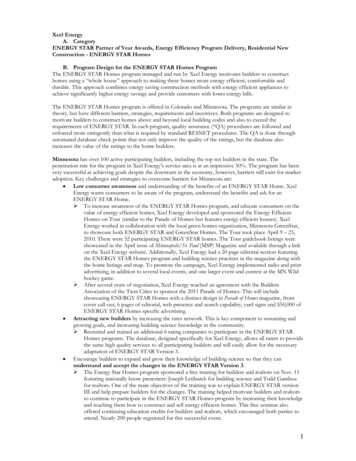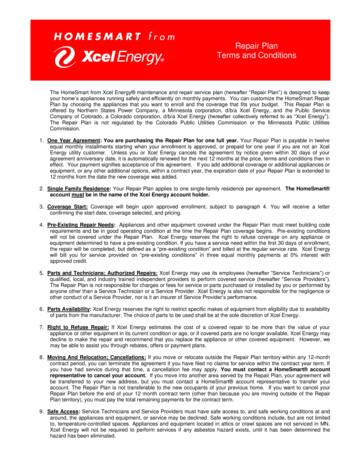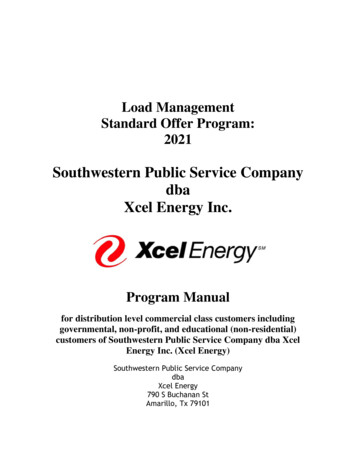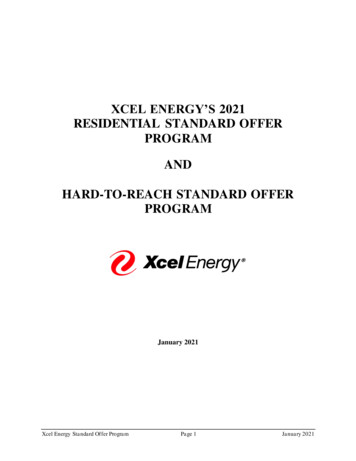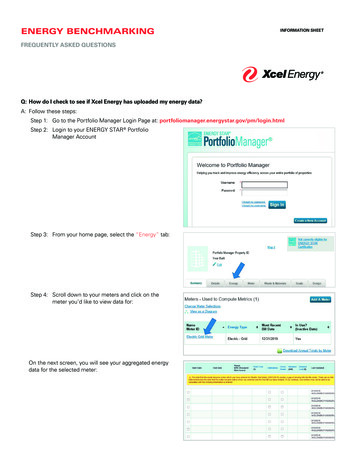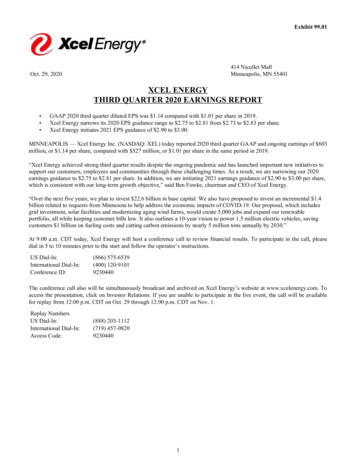
Transcription
Exhibit 99.01414 Nicollet MallMinneapolis, MN 55401Oct. 29, 2020XCEL ENERGYTHIRD QUARTER 2020 EARNINGS REPORT GAAP 2020 third quarter diluted EPS was 1.14 compared with 1.01 per share in 2019.Xcel Energy narrows its 2020 EPS guidance range to 2.75 to 2.81 from 2.73 to 2.83 per share.Xcel Energy initiates 2021 EPS guidance of 2.90 to 3.00.MINNEAPOLIS — Xcel Energy Inc. (NASDAQ: XEL) today reported 2020 third quarter GAAP and ongoing earnings of 603million, or 1.14 per share, compared with 527 million, or 1.01 per share in the same period in 2019.“Xcel Energy achieved strong third quarter results despite the ongoing pandemic and has launched important new initiatives tosupport our customers, employees and communities through these challenging times. As a result, we are narrowing our 2020earnings guidance to 2.75 to 2.81 per share. In addition, we are initiating 2021 earnings guidance of 2.90 to 3.00 per share,which is consistent with our long-term growth objective,” said Ben Fowke, chairman and CEO of Xcel Energy.“Over the next five years, we plan to invest 22.6 billion in base capital. We also have proposed to invest an incremental 1.4billion related to requests from Minnesota to help address the economic impacts of COVID-19. Our proposal, which includesgrid investment, solar facilities and modernizing aging wind farms, would create 5,000 jobs and expand our renewableportfolio, all while keeping customer bills low. It also outlines a 10-year vision to power 1.5 million electric vehicles, savingcustomers 1 billion on fueling costs and cutting carbon emissions by nearly 5 million tons annually by 2030.”At 9:00 a.m. CDT today, Xcel Energy will host a conference call to review financial results. To participate in the call, pleasedial in 5 to 10 minutes prior to the start and follow the operator’s instructions.US Dial-In:International Dial-In:Conference ID:(866) 575-6539(400) 120-91019230440The conference call also will be simultaneously broadcast and archived on Xcel Energy’s website at www.xcelenergy.com. Toaccess the presentation, click on Investor Relations. If you are unable to participate in the live event, the call will be availablefor replay from 12:00 p.m. CDT on Oct. 29 through 12:00 p.m. CDT on Nov. 1.Replay NumbersUS Dial-In:International Dial-In:Access Code:(888) 203-1112(719) 457-082092304401
Except for the historical statements contained in this report, the matters discussed herein are forward-looking statements that aresubject to certain risks, uncertainties and assumptions. Such forward-looking statements, including the 2020 earnings per share(EPS) guidance, 2021 EPS guidance, long-term EPS and dividend growth rate objectives, future sales, future bad debt expense,future operating performance, estimated base capital expenditures and financing plans, projected capital additions andforecasted annual revenue requirements with respect to rider filings, and expectations regarding regulatory proceedings, as wellas assumptions and other statements are intended to be identified in this document by the words “anticipate,” “believe,”“could,” “estimate,” “expect,” “intend,” “may,” “objective,” “outlook,” “plan,” “project,” “possible,” “potential,” “should,”“will,” “would” and similar expressions. Actual results may vary materially. Forward-looking statements speak only as of thedate they are made, and we expressly disclaim any obligation to update any forward-looking information. The followingfactors, in addition to those discussed in Xcel Energy’s Annual Report on Form 10-K for the fiscal year ended Dec. 31, 2019and subsequent filings with the Securities and Exchange Commission, could cause actual results to differ materially frommanagement expectations as suggested by such forward-looking information: uncertainty around the impacts and duration ofthe COVID-19 pandemic; operational safety, including our nuclear generation facilities; successful long-term operationalplanning; commodity risks associated with energy markets and production; rising energy prices and fuel costs; qualifiedemployee work force and third-party contractor factors; ability to recover costs, changes in regulation and subsidiaries’ abilityto recover costs from customers; reductions in our credit ratings and the cost of maintaining certain contractual relationships;general economic conditions, including inflation rates, monetary fluctuations and their impact on capital expenditures and theability of Xcel Energy Inc. and its subsidiaries to obtain financing on favorable terms; availability or cost of capital; ourcustomers’ and counterparties’ ability to pay their debts to us; assumptions and costs relating to funding our employee benefitplans and health care benefits; our subsidiaries’ ability to make dividend payments; tax laws; effects of geopolitical events,including war and acts of terrorism; cyber security threats and data security breaches; seasonal weather patterns; changes inenvironmental laws and regulations; climate change and other weather; natural disaster and resource depletion, includingcompliance with any accompanying legislative and regulatory changes; and costs of potential regulatory penalties.For more information, contact:Paul Johnson, Vice President, Investor Relations(612) 215-4535For news media inquiries only, please call Xcel Energy Media Relations(612) 215-5300Xcel Energy website address: www.xcelenergy.comThis information is not given in connection with anysale, offer for sale or offer to buy any security.2
XCEL ENERGY INC. AND SUBSIDIARIESCONSOLIDATED STATEMENTS OF INCOME (UNAUDITED)(amounts in millions, except per share data)Three Months Ended Sept. 302020Operating revenuesElectricNatural gasOtherTotal operating revenues Operating expensesElectric fuel and purchased powerCost of natural gas sold and transportedCost of sales — otherOperating and maintenance expensesConservation and demand side management expensesDepreciation and amortizationTaxes (other than income taxes)Total operating expensesNine Months Ended Sept. 3020192,941219223,182 20202,771222203,013 20197,4301,082678,579 (6)2991142955Interest charges and financing costsInterest charges — includes other financing costs of 7, 6, 21 and 19, respectivelyAllowance for funds used during construction — debtTotal interest charges and financing costs221(11)210199(7)192628(33)595578(27)551Income before income taxesIncome tax expenseNet income6464360359972527Operating incomeOther income (expense), netEquity earnings of unconsolidated subsidiariesAllowance for funds used during construction — equity Weighted average common shares outstanding:BasicDilutedEarnings per average common share:BasicDiluted 526528 31.151.14 519521 1.021.011,209241,185 526527 2.252.251,2011211,080517518 2.092.08
XCEL ENERGY INC. AND SUBSIDIARIESNotes to Investor Relations Earnings Release (Unaudited)Due to the seasonality of Xcel Energy’s operating results, quarterly financial results are not an appropriate base from which toproject annual results.Non-GAAP Financial MeasuresThe following discussion includes financial information prepared in accordance with generally accepted accounting principles(GAAP), as well as certain non-GAAP financial measures such as ongoing return on equity (ROE), electric margin, natural gasmargin, ongoing earnings and ongoing diluted EPS. Generally, a non-GAAP financial measure is a measure of a company’sfinancial performance, financial position or cash flows that excludes (or includes) amounts that are adjusted from measurescalculated and presented in accordance with GAAP. Xcel Energy’s management uses non-GAAP measures for financialplanning and analysis, for reporting of results to the Board of Directors, in determining performance-based compensation, andcommunicating its earnings outlook to analysts and investors. Non-GAAP financial measures are intended to supplementinvestors’ understanding of our performance and should not be considered alternatives for financial measures presented inaccordance with GAAP. These measures are discussed in more detail below and may not be comparable to other companies’similarly titled non-GAAP financial measures.Ongoing ROEOngoing ROE is calculated by dividing the net income or loss of Xcel Energy or each subsidiary, adjusted for certainnonrecurring items, by each entity’s average stockholder’s equity. We use these non-GAAP financial measures to evaluate andprovide details of earnings results.Electric and Natural Gas MarginsElectric margin is presented as electric revenues less electric fuel and purchased power expenses. Natural gas margin ispresented as natural gas revenues less the cost of natural gas sold and transported. Expenses incurred for electric fuel andpurchased power and the cost of natural gas are generally recovered through various regulatory recovery mechanisms. As aresult, changes in these expenses are generally offset in operating revenues. Management believes electric and natural gasmargins provide the most meaningful basis for evaluating our operations because they exclude the revenue impact offluctuations in these expenses. These margins can be reconciled to operating income, a GAAP measure, by including otheroperating revenues, cost of sales - other, operating and maintenance (O&M) expenses, conservation and demand sidemanagement (DSM) expenses, depreciation and amortization and taxes (other than income taxes).Earnings Adjusted for Certain Items (Ongoing Earnings and Ongoing Diluted EPS)GAAP diluted EPS reflects the potential dilution that could occur if securities or other agreements to issue common stock (i.e.,common stock equivalents) were settled. The weighted average number of potentially dilutive shares outstanding used tocalculate Xcel Energy Inc.’s diluted EPS is calculated using the treasury stock method. Ongoing earnings reflect adjustments toGAAP earnings (net income) for certain items. Ongoing diluted EPS is calculated by dividing the net income or loss of eachsubsidiary, adjusted for certain items, by the weighted average fully diluted Xcel Energy Inc. common shares outstanding forthe period. Ongoing diluted EPS for each subsidiary is calculated by dividing the net income or loss of such subsidiary, adjustedfor certain items, by the weighted average fully diluted Xcel Energy Inc. common shares outstanding for the period.We use these non-GAAP financial measures to evaluate and provide details of Xcel Energy’s core earnings and underlyingperformance. We believe these measurements are useful to investors to evaluate the actual and projected financial performanceand contribution of our subsidiaries. For the three and nine months ended Sept. 30, 2020 and 2019, there were no suchadjustments to GAAP earnings and therefore GAAP earnings equal ongoing earnings for these periods.4
Note 1. Earnings Per Share SummaryXcel Energy’s 2020 third quarter earnings were 1.14 per share compared to 1.01 per share in 2019, primarily reflectinghigher electric margin (largely due to capital investment recovery) and allowance for funds used during construction (AFUDC),which offset increased depreciation and declining sales due to the impacts of COVID-19. Third quarter sales declined on aweather-adjusted basis, but exceeded our previous assumptions. There continues to be uncertainty related to the impact of thepandemic on the remainder of the year.All companies were negatively impacted by the pandemic starting in March 2020 and continuing into the third quarter. SeeNote 5 for further information regarding COVID-19, including estimated impact on weather-adjusted electric sales.Summarized diluted EPS for Xcel Energy:Three Months Ended Sept. 30Diluted Earnings (Loss) Per ShareNSP-MinnesotaPSCoSPSNSP-WisconsinEquity earnings of unconsolidated subsidiariesRegulated utility (a)Xcel Energy Inc. and OtherTotal (a)(a)2020 Nine Months Ended Sept. 3020190.460.420.240.080.01 1.21(0.07)1.14 20200.400.390.200.060.01 1.06(0.05)1.01 20190.890.870.460.160.04 2.42(0.17)2.25 0.810.860.420.120.042.24(0.16)2.08Amounts may not add due to rounding.NSP-Minnesota — Earnings increased 0.06 per share for the third quarter of 2020 and 0.08 per share year-to-date. Year-todate results reflect lower O&M expenses and higher electric margin (regulatory outcomes offset lower sales primarily due toCOVID-19), partially offset by increased depreciation and lower natural gas margin.PSCo — Earnings increased 0.03 per share for the third quarter of 2020 and 0.01 per share year-to date. The increase in yearto-date earnings was driven by higher electric margin (regulatory outcomes offset lower sales due to COVID-19), increasedAFUDC and reduced O&M expenses, partially offset by higher depreciation, interest expense and taxes (other than incometaxes).SPS — Earnings increased 0.04 per share for the third quarter of 2020 and 0.04 per share year-to-date. Year-to-date resultsreflect higher electric margin (regulatory outcomes offset lower sales due to COVID-19) and lower O&M expenses, partiallyoffset by increased depreciation, interest expense and taxes (other than income taxes).NSP-Wisconsin — Earnings increased 0.02 per share for the third quarter of 2020 and 0.04 per share year-to-date. Theincrease in year-to-date earnings was driven by higher electric margin (2020 Wisconsin Fuel Settlement offset lower sales dueto COVID-19) and AFUDC, as well as lower O&M expenses. These items were partially offset by increased depreciation andlower natural gas margin.Xcel Energy Inc. and Other — Primarily includes financing costs at the holding company.5
Components significantly contributing to changes in 2020 EPS compared with the same period in 2019:Three MonthsEnded Sept. 30Diluted Earnings (Loss) Per ShareGAAP and ongoing diluted EPS - 2019 Components of change - 2020 vs. 2019Higher electric margin (a)Lower ETR (b)Lower O&MHigher AFUDCHigher depreciation and amortizationHigher interest chargesLower natural gas marginsLower other income (expense), netOther (net)GAAP and ongoing diluted EPS - 2020(a) 2.080.200.07—0.03(0.09)(0.03)—(0.01)(0.04)1.14 Period-over-period change in electric margin was negatively impacted by reductions in sales and demand due to COVID-19as follows:Three MonthsEnded Sept. 30Diluted Earnings (Loss) Per ShareElectric margin (excluding reductions in sales and demand)Reductions in sales and demand (*)Higher electric margins(*)(b)1.01Nine Months EndedSept. 30 Nine MonthsEnded Sept. 300.21 (0.01)0.20 0.30(0.08)0.22Sales decline excludes weather impact, net of decoupling/sales true-up and decrease in demand revenue is net of sales true-up.Includes production tax credits (PTCs) and tax reform regulatory amounts, which are primarily offset in electric margin.Note 2. Regulated Utility ResultsEstimated Impact of Temperature Changes on Regulated Earnings — Unusually hot summers or cold winters increaseelectric and natural gas sales, while mild weather reduces electric and natural gas sales. The estimated impact of weather onearnings is based on the number of customers, temperature variances, the amount of natural gas or electricity historically usedper degree of temperature and excludes any incremental related operating expenses that could result due to storm activity orvegetation management requirements. As a result, weather deviations from normal levels can affect Xcel Energy’s financialperformance.Degree-day or Temperature-Humidity Index (THI) data is used to estimate amounts of energy required to maintain comfortableindoor temperature levels based on each day’s average temperature and humidity. Heating degree-days (HDD) is the measure ofthe variation in the weather based on the extent to which the average daily temperature falls below 65 Fahrenheit. Coolingdegree-days (CDD) is the measure of the variation in the weather based on the extent to which the average daily temperaturerises above 65 Fahrenheit. Each degree of temperature above 65 Fahrenheit is counted as one CDD, and each degree oftemperature below 65 Fahrenheit is counted as one HDD. In Xcel Energy’s more humid service territories, a THI is used inplace of CDD, which adds a humidity factor to CDD. HDD, CDD and THI are most likely to impact the usage of Xcel Energy’sresidential and commercial customers. Industrial customers are less sensitive to weather.Normal weather conditions are defined as either the 10, 20 or 30-year average of actual historical weather conditions. Thehistorical period of time used in the calculation of normal weather differs by jurisdiction, based on regulatory practice. Tocalculate the impact of weather on demand, a demand factor is applied to the weather impact on sales. Extreme weathervariations, windchill and cloud cover may not be reflected in weather-normalized estimates.6
Percentage increase (decrease) in normal and actual HDD, CDD and THI:Three Months Ended Sept. 302020 vs.NormalHDDCDDTHI2019 vs.Normal48.4 %20.74.6Nine Months Ended Sept. 302020 vs.Normal2020 vs. 2019(64.0)%27.4(2.6)251.2 %1.38.32019 vs.Normal(2.8)%21.27.02020 vs. 201910.7 %6.4(8.2)(11.2)%21.318.3Weather — Estimated impact of temperature variations on EPS compared with normal weather conditions:Three Months Ended Sept. 302020 vs.NormalRetail electricDecoupling and sales true-upElectric totalFirm natural gasTotal 2019 vs.Normal0.079 (0.035)0.044 —0.044 Nine Months Ended Sept. 302020 vs.Normal2020 vs. 20190.040 —0.040 (0.001)0.039 0.039 (0.035)0.004 0.0010.005 2019 vs.Normal0.096 (0.044)0.052 (0.005)0.047 2020 vs. 20190.035 0.0010.036 0.0210.057 0.061(0.045)0.016(0.026)(0.010)Sales — Sales growth (decline) for actual and weather-normalized sales in 2020 compared to the same period in 2019:Three Months Ended Sept. 30PSCoNSP-MinnesotaSPSNSP-WisconsinXcel Energy(a)ActualElectric residentialElectric C&ITotal retail electric salesFirm natural gas sales8.7 %(4.5)(0.1)1.111.8 %(5.2)0.12.14.4 %(5.5)(3.5)N/A6.6 %(4.1)(1.2)11.29.1 %(5.0)(0.9)2.0Three Months Ended Sept. 30PSCoWeather-Normalized (a)Electric residentialElectric C&ITotal retail electric salesFirm natural gas salesNSP-Minnesota3.8 %(4.2)(1.6)(4.8)4.3 %(5.3)(2.3)(1.8)SPSNSP-Wisconsin2.2 %(5.0)(3.5)N/A2.0 %(4.6)(2.7)6.6Xcel Energy3.7 %(4.8)(2.4)(3.3)Nine Months Ended Sept. 30PSCoActual (a)Electric residentialElectric C&ITotal retail electric salesFirm natural gas salesNSP-Minnesota6.9 %(4.2)(0.7)(7.3)5.6 %(7.3)(3.4)(9.3)SPSNSP-Wisconsin5.0 %(3.4)(2.0)N/A2.9 %(5.6)(3.2)(9.9)Xcel Energy5.8 %(5.2)(2.2)(8.1)Nine Months Ended Sept. 30PSCoWeather-Normalized (a)Electric residentialElectric C&ITotal retail electric salesFirm natural gas salesNSP-Minnesota3.5 %(4.7)(2.1)(1.7)3.3 %(7.5)(4.2)2.27SPS2.0 %(3.5)(2.6)N/ANSP-Wisconsin2.7 %(5.8)(3.4)3.6Xcel Energy3.2 %(5.5)(3.1)(0.2)
Nine Months Ended Sept. 30 (Leap Year Adjusted)PSCoWeather-Normalized (a)Electric residentialElectric C&ITotal retail electric salesFirm natural gas sales(a)NSP-Minnesota3.2 %(5.1)(2.5)(2.5)3.0 %(7.8)(4.6)1.4SPSNSP-Wisconsin1.6 %(3.9)(3.0)N/AXcel Energy2.3 %(6.2)(3.8)2.82.8 %(5.8)(3.5)(1.0)Higher residential sales and lower commercial and industrial (C&I) sales were primarily attributable to COVID-19.Weather-normalized and leap-year adjusted electric sales growth (decline) — year-to-date (excluding leap day) PSCo — Residential sales rose based on higher use per customer from increased working from home and an increasednumber of customers. The decline in C&I sales was primarily due to the economic contraction from COVID-19,particularly noted within the manufacturing and service industries.NSP-Minnesota — Residential sales growth reflects higher use per customer from increased working from home andan increase in customers. Decrease in C&I sales were driven by the energy, manufacturing and services sectors,primarily related to COVID-19.SPS — Residential sales increased due to customer growth and higher use per customer from increased working fromhome. The decline in C&I sales was driven by shutdowns of the economy from COVID-19, primarily within theenergy and manufacturing sectors.NSP-Wisconsin — Residential sales growth was attributable to higher use per customer from increased working fromhome and customer additions. The decline in C&I sales was largely related to COVID-19, specifically decreased salesto the manufacturing sector.Weather-normalized and leap-year adjusted natural gas sales growth (decline) — year-to-date (excluding leap day) Natural gas sales reflect primarily lower C&I customer use due to the economic contraction from COVID-19, partiallyoffset by an increase in number of residential and C&I customers.Electric Margin — Electric revenues and fuel and purchased power expenses are impacted by fluctuations in the price ofnatural gas, coal and uranium. However, these price fluctuations have minimal impact on electric margin due to fuel recoverymechanisms that recover fuel expenses. In addition, electric customers receive a credit for PTCs generated, which reducedelectric revenue and margin.Electric revenues and margin:Three Months Ended Sept. 30(Millions of Dollars)Electric revenuesElectric fuel and purchased powerElectric margin2020 2,941 (981)1,960 820192,771 (952)1,819 Nine Months Ended Sept. 3020207,430 (2,611)4,819 20197,345(2,679)4,666
Changes in electric margin:Three MonthsEnded Sept. 30,2020 vs. 2019(Millions of Dollars)Regulatory rate outcomes (Colorado, Wisconsin, Texas and New Mexico) (a)Non-fuel ridersWholesale transmission revenue (net)MEC purchased capacity costs (b)Estimated impact of weather (net of decoupling/sales true-up)PTCs flowed back to customers (offset by lower ETR)Sales and demand (c)Other (net)Total increase in electric margin Nine MonthsEnded Sept. 30,2020 vs. 2019123 191044(28)(9)18141 15843353512(81)(56)7153(a)Includes approximately 70 million of revenue and margin due to the Texas rate case outcome, which is largely offset byrecognition of previously deferred costs, see Note 4 for additional information.(b)Prior to the Mankato Energy Center (MEC) acquisition (first quarter of 2020), all purchased power costs were recorded as acomponent of electric fuel and purchased power. During Xcel Energy’s ownership of MEC, all non-fuel related costsincluding depreciation, O&M and interest expenses were recorded within separate statement of income line items in ourconsolidated financial results. MEC was sold in the third quarter of 2020.(c)Sales increase (decline) excludes weather impact, net of decoupling/sales true-up, and decrease in demand revenue is net ofsales true-up.Natural Gas Margin — Natural gas expense varies with changing sales and the cost of natural gas. However, fluctuations inthe cost of natural gas has minimal impact on natural gas margin due to cost recovery mechanisms.Natural gas revenues and margin:Three Months Ended Sept. 30(Millions of Dollars)Natural gas revenuesCost of natural gas sold and transportedNatural gas margin2020 2019219 (54)165 Nine Months Ended Sept. 302020222 (55)167 20191,082 (425)657 1,324(646)678Changes in natural gas margin:Three MonthsEnded Sept. 30,2020 vs. 2019(Millions of Dollars)Estimated impact of weatherRetail sales declineRegulatory rate outcomes (Wisconsin)Transport salesInfrastructure and integrity ridersOther (net)Total decrease in natural gas margin 9Nine MonthsEnded Sept. 30,2020 vs. 20191 (1)—11(4)(2) (18)(2)(2)(1)6(4)(21)
O&M Expenses — O&M expenses decreased 1 million, or 0.2%, for the third quarter and 56 million, or 3.2%, year-to-date,largely reflecting management actions to reduce costs to offset the impact of lower sales from COVID-19. Significant changesare summarized as follows:Three MonthsEnded Sept. 30,2020 vs. 2019(Millions of Dollars)DistributionTransmissionGenerationTexas rate case deferralOther (net)Total decrease in O&M expenses Nine MonthsEnded Sept. 30,2020 vs. 2019(10) (4)(3)133(1) (40)(10)(8)5(3)(56)Distribution declined due to cost mitigation/continuous improvement efforts and the timing of maintenance activities.Transmission declined due to cost mitigation/continuous improvement initiatives.Generation was lower from timing of maintenance and overhauls at power plants and cost mitigation/continuousimprovement efforts, which were partially offset by an increase in wind related O&M expenses from our renewableexpansion.Texas rate case deferral amounts were due to recognition of previously deferred amounts related with the TexasElectric Rate Case.Included within Other (net) are amounts associated with the sale of MEC. During the third quarter of 2020, XcelEnergy recognized a net gain of approximately 20 million on the sale, which was offset by charitable giving,including COVID-19 relief efforts.Depreciation and Amortization — Depreciation and amortization increased 66 million, or 14.8%, for the third quarter and 130 million, or 9.9%, year-to-date. Increase was primarily driven by Hale, Lake Benton, Foxtail, Blazing Star I and CheyenneRidge wind facilities going into service, as well as normal system expansion. In addition, new depreciation rates wereimplemented in Colorado, New Mexico and Texas as part of regulatory outcomes in 2020.Other Income (Expense) — Other income (expense) decreased 7 million for the third quarter and 20 million year-to-date.The decrease was substantially due to the performance of rabbi trust investments primarily in the first half of 2020, which wasoffset in O&M expenses.AFUDC, Equity and Debt — AFUDC increased 19 million for the third quarter and 42 million year-to-date. Increase wasprimarily due to various wind projects under construction.Interest Charges — Interest charges increased 22 million, or 11.1%, for the third quarter and 50 million, or 8.7% year-todate. The increase was largely due to higher debt levels to fund capital investments, partially offset by lower long-term andshort-term interest rates.Income Taxes — Income taxes decreased 29 million for the third quarter. The decrease was primarily driven by an increase inwind PTCs, an increase in plant regulatory differences and a carryback tax benefit, partially offset by higher pretax earnings.Wind PTCs are credited to customers (recorded as a reduction to revenue) and do not have a material impact on net income.The effective tax rate (ETR) was 6.7% for the third quarter of 2020 compared with 12.0% for 2019.Income taxes decreased 97 million year-to-date. The decrease was primarily driven by an increase in wind PTCs and anincrease in plant-related regulatory differences. Wind PTCs are credited to customers and do not have a material impact on netincome. The ETR was 2.0% for the first nine months ending Sept. 30, 2020 compared with 10.1% for 2019.10
Additional details:Three Months Ended Sept. 30Federal statutory rateState tax (net of federal tax effect)(Decreases) increases:Wind PTCsPlant regulatory differences (a)Net Operating Loss carrybackOther tax credits and NOL allowances (net)Other (net)Effective income tax rate(a)2020201921.0 %5.021.0 %5.0(8.0)(7.2)(1.9)(1.0)(1.2)6.7 %(6.1)(5.6)—(1.7)(0.6)12.0 %Nine Months Ended Sept. 302020 vs 201920202019—%—21.0 %5.121.0 %5.02020 vs )(1.0)(1.2)(1.3)2.0 %(8.1)(5.5)—(1.8)(0.5)10.1 %(5.1)(1.9)(1.0)0.6(0.8)(8.1)%Regulatory differences for income tax primarily relate to the credit of excess deferred taxes to customers. Income tax benefitsassociated with the credit of excess deferred credits are generally offset by corresponding revenue reductions.Note 3. Capital Structure, Liquidity, Financing and Credit RatingsXcel Energy’s capital structure:(Millions of Dollars)Percentage of TotalCapitalizationSept. 30, 2020 Current portion of long-term debtShort-term debtLong-term debtTotal debtCommon equityTotal capitalization40150019,96020,86113,77734,638 Percentage of TotalCapitalizationDec. 31, 20191% 1586040100 % 70259517,40718,70413,23931,9432%2545842100 %Liquidity — As of Oct. 26, 2020, Xcel Energy Inc. and its utility subsidiaries had the following committed credit facilitiesavailable to meet liquidity needs:(Millions of Dollars)Xcel Energy Inc.PSCoNSP-MinnesotaSPSNSP-WisconsinTotalTerm Loan (c)(a)(b)(c)Credit Facility (a)1,2507005005001503,100500Drawn (b)Available—810161044500 1,2506924904841403,056—Cash Liquidity26922021—474 1,5196946924851403,530Credit facilities expire in June 2024.Includes outstanding commercial paper and letters of credit.The 500 million term loan matures in December 2020.Term Loan Agreements — In December 2019, Xcel Energy Inc. extended a 500 million Term Loan Agreement for anadditional 364 days. In September 2020, Xcel Energy Inc. repaid its 700 million 364-Day Term Loan Agreement that wasentered into in March 2020.Bilateral Credit Agreement — In March 2020, NSP-Minnesota extended an uncommitted bilateral credit agreement of 75million, which is limited in use to support letters of credit for one-year. NSP-Minnesota had 46 million of outstanding lettersof credits as of Sept. 30, 2020.Forward Equity Agreements — In November 2019, Xcel Energy Inc. entered into forward equity agreements in connectionwith a 743 million public offering of 11.8 million shares, which is expected to be settled in shares later in 2020.11
Credit Ratings — Access to the capital markets at reasonable terms is partially dependent on credit ratings. The followingratings reflect the views of Moody’s, S&P Global Ratings, and Fitch. The highest credit rating for debt is Aaa/AAA and thelowest investment grade rating is Baa3/BBB-. The highest rating for commercial paper is P-1/A-1/F-1 and the lowest rating isP-3/A-3/F-3. A security rating is not a recommendation to buy, sell or hold securities. Ratings are subject to revision orwithdrawal at any time by the credit rating agency and each rati
Oct 1, 2020





